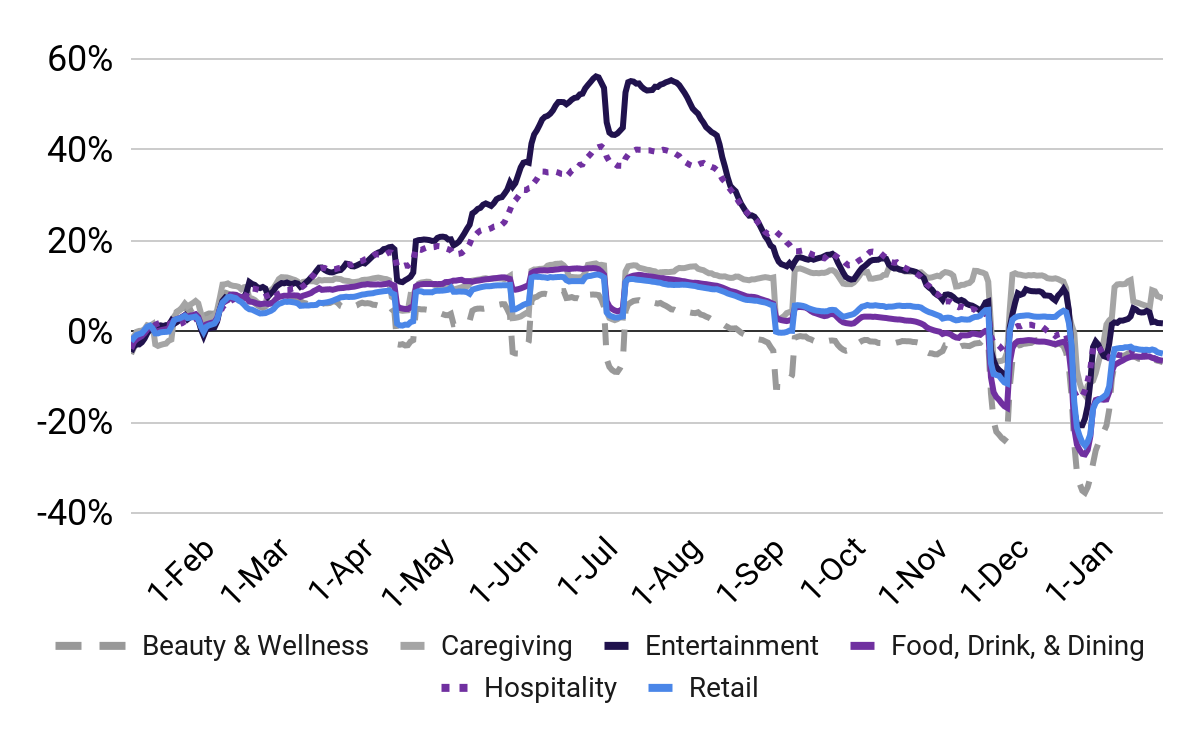The past few months have seen economists and regulators worry about the impact of continued wage growth on inflation and employer outlook. After significant rate hikes from the Fed, indicators are beginning to slowly revert.
Our data from the US and Canada reflects a new year ebb in economic activity at small businesses.
Past versions of this report have discussed continued concern over the pace of wage growth and low jobless claims leading the Fed to maintain its strong approach to rate hikes. As signals of an economy running hot begin to abate, Homebase seeks to understand how the broader economic environment is affecting small businesses and their employees during the start of 2023 by analyzing behavioral data from more than two million employees working at more than one hundred thousand SMBs.
Summary of findings: Homebase high-frequency timesheet data indicate continued slowdown in hours worked and employees working, across most industries and major metro areas
- January has seen a slow start with a continuing downward trajectory; whereas 2022 saw growth in hours worked through Q1, 2023 levels for employees working and hours worked are 4-5 percentage points below their January 2022 marks.
- Post-holiday declines across industries are softer than what we saw pre-COVID with the exception of caregiving; workforce participation in entertainment has rebounded the most significantly from holiday lows, only 2.3% below mid-December levels.
- Hours worked across metro areas remain slightly below their pre-holiday levels, a trend similar to prior years; however, January 2023 levels have remained relatively constant through the month, rather than rising as they did in 2021 and 2022.
January has seen a slow start with a continuing downward trajectory; whereas 2022 saw growth in hours worked through Q1, 2023 levels for employees working and hours worked are 4-5 percentage points below their January 2022 marks.
Employees working
(Rolling 7-day average; relative to Jan. of reported year)

Main Street Health Metrics1
(Rolling 7-day average; relative to Jan. 2022)

1. Some significant dips due to major U.S. holidays. Pronounced dip in mid-February 2021 coincides with the period including the Texas power crisis and severe weather in the Midwest. Dip in late September coincides with Hurricane Ian. Source: Homebase data.
Post-holiday declines across industries are softer than what we saw pre-COVID with the exception of caregiving; workforce participation in entertainment has rebounded the most significantly from holiday lows, only 2.3% below mid-December levels.
Percent change in employees working
(Compared to January 2022 baseline using 7-day rolling average)1

Percent change in employees working
(Mid-January vs. mid-December of prior year, using Jan. ‘22 and Jan. ‘19 baselines)1

1. January 15-21 vs. December 11-17 (2022/2023) and January 12-18 vs. December 8-14 (2019/2020). Pronounced dips generally coincide with major US Holidays. Source: Homebase data
Hours worked across metro areas remain slightly below their pre-holiday levels, a trend similar to prior years; however, January 2023 levels have remained relatively constant through the month, rather than rising as they did in 2021 and 2022.
Hours worked
(Rolling 7-day average; relative to Jan. 2020 (pre-Covid))

1. Some significant dips due to major U.S. holidays. Pronounced dip in mid-February 2021 coincides with the period including the Texas power crisis and severe weather in the Midwest. Source: Homebase data.
For a PDF of our January report, please visit this PDF; if you choose to use this data for research or reporting purposes, please cite Homebase.
Link to PDF of: January 2023 Homebase Main Street Health Report
